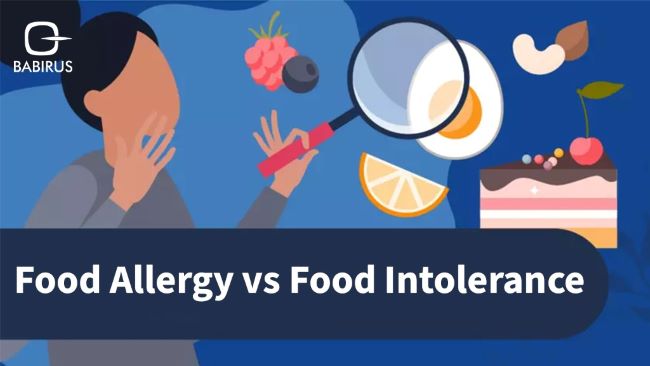Food Allergies vs Food Intolerance

Although food allergies vs food intolerance are very different medical situations in symptoms and reactions, yet some people confuse them together.
Moreover, food intolerance could lead to some bloated and uncomfortable feelings, while food allergies are considered more dangerous and could cause you to break out in hives or even struggle to breathe.
Continue reading our article to understand more about food allergies vs food intolerance concept with key differences between food allergies and food intolerance, diagnosis, management, and more!
Demystifying Food Reactions:
The digestive system is the part of our body that is responsible for breaking down the food we eat into nutrients, which the body uses for energy, growth, and cell repair. The system consists of several parts and each one has its unique role:
- The mouth, where food is chewed and mixed with saliva.
- The food then travels down the esophagus to the stomach.
- At the stomach, the food will be mixed with digestive juices, as the stomach’s acidic environment helps break down proteins.
- The partially digested food moves to the small intestine, where most nutrients are absorbed.
- The pancreas, liver, and gallbladder aid digestion by producing enzymes and bile that help break down fats, proteins, and carbohydrates.
- The remaining undigested food moves to the large intestine, where water is absorbed, and the leftover material is eventually excreted.
However, this complex process can sometimes be disrupted by adverse reactions to certain foods which are called food allergies or food intolerances.
Understanding Food Allergies:
In some cases, a person’s immune system falsely classifies certain food proteins as a risk factor, leading to triggering an allergic reaction shown by producing antibodies called Immunoglobulin E (IgE), which recognize and restrict the food proteins, leading to the release of chemicals like histamine.
Moreover, this immune response can cause different symptoms that vary in severity, from mild to life-threatening. More than that, certain foods are more likely to cause allergic reactions than others, yet they differ from one person to another.
Some of the most common food allergens include:
- Peanuts: Known for causing severe and often lifelong allergies.
- Milk: Frequently affects children, though many outgrow it by adulthood.
- Eggs: Common in children but often outgrown as they grow older.
- Shellfish: Includes both crustaceans and mollusks and often persists into adulthood.
- Soy: Typically seen in infants, with many outgrowing it.
- Wheat: Can cause both allergies and intolerances.
- Tree Nuts: Includes almonds, walnuts, cashews, and more, often causing severe reactions.
- Fish: Similar to shellfish, this allergy can last a lifetime.
Identifying and knowing your allergy symptoms, which could affect different parts of the body, is vital in managing food allergies, so you can manage and mitigate your food allergies and the associated risks, here are the most common symptoms of food allergies:
- Skin Reactions: Hives, eczema, and itching.
- Digestive Issues: Nausea, vomiting, and diarrhea.
- Respiratory Problems: Wheezing, nasal congestion, and trouble breathing.
- Anaphylaxis: A severe, life-threatening reaction that requires immediate medical attention. Symptoms can include difficulty breathing, a significant drop in blood pressure, and loss of consciousness.
Shedding Light on Food Intolerances:
When talking about food allergies vs food intolerance, then you must understand the big difference between them, as food allergies, involve an immune system response and could be life-threatening, while food intolerance is all about the digestive system’s inability to properly break down certain foods, leading to discomfort without triggering the immune system.
Common food intolerances include:
- Lactose Intolerance: Caused by a deficiency in lactase, the enzyme needed to digest lactose found in dairy products. People with lactose intolerance often experience discomfort after consuming milk, cheese, or other dairy products.
- Gluten Intolerance: Also known as non-celiac gluten sensitivity, this condition involves adverse reactions to gluten, a protein found in wheat, barley, and rye. Unlike celiac disease, gluten intolerance does not damage the intestines but can still cause significant symptoms.
Symptoms of food intolerances can often be milder and delayed compared to food allergies. These symptoms include:
- Gas and Bloating: Common in lactose intolerance and other carbohydrate malabsorption issues.
- Abdominal Pain: A frequent symptom of various food intolerances.
- Diarrhea: Often seen with lactose and gluten intolerances.
- Headaches: Sometimes triggered by certain food additives or intolerances.
However, although food intolerances directly impact the quality of your daily life, yet, with the right dietary adjustments you can easily manage your symptoms and the discomfort from food intolerances.
4 Key Distinguishing Factors:
We have the food allergies vs food intolerance concept due to the high importance of differentiating between food allergies and food intolerances, as while both conditions will impact your quality of life, yet, they do so in different ways.
- Food allergies involve the immune system and can cause severe, immediate reactions.
- Food intolerances involve the digestive system and typically lead to milder, delayed symptoms.
Thus, being able to separate between the two is crucial for effective management and treatment. Here’s a summary of the key differences between food allergies and food intolerances:
| Factor | Food Allergies | Food Intolerances |
| Trigger | Immune System reaction to proteins | Digestive System’s inability to process certain foods |
| Symptoms | Severe and immediate (skin reactions, anaphylaxis) | Milder and delayed (bloating, headaches) |
| Diagnosis Methods | Skin prick tests, blood tests, tIgE and sIgE tests | Elimination diets, food challenges, IgG Antibody tests |
| Management Strategies | Avoiding allergens, carrying epinephrine | Identifying triggers, modifying diet |
Diagnosis and Management:
As we discussed earlier food allergies vs food intolerance are two different concepts, thus, consulting a healthcare professional is required to get a proper diagnosis of food allergies or food intolerances.
Furthermore, accurate identification of the specific condition leads to appropriate management and treatment, here are the commonly used methods for diagnosing food allergies and intolerances:
Food Allergy Testing:
Usually, the food allergy is tested and diagnosed with skin prick tests and blood tests to identify the specific allergens that trigger reactions.
One of the most advanced methods to identify food allergies is the ALEX 2 test from MADx, which is the first in vitro multiplex allergy test allowing simultaneous measurement of total IgE (tIgE) and specific IgE (sIgE) against a wide array of allergen extracts and molecular allergens. Moreover, this test provides a near-complete picture of each patient’s sensitization status using proprietary nano-bead technology, with flexible analysis software that allows for tailor-made allergen panels, that adapt to clinical needs.
Food Intolerance Testing:
Diagnosing food intolerances often involves various methods:
- Elimination Diets: Removing suspected foods from the diet and renter them one by one into your diet while monitoring symptoms.
- Food Challenges: Consuming small amounts of the suspected food under medical supervision to observe reactions.
- FoodPrint® Test by Omega Diagnostics: An advanced method that analyses up to 222 foods for IgG antibodies. Trusted by more than 150 laboratories worldwide, the FoodPrint® test offers a fast track to a guided elimination diet. With just 5µL of serum required, patients can take the sample at home or in a clinic. The results are easy to interpret using a “traffic light system” and quantified reactions in IgG/ml, providing a detailed guide to patient food elimination.
Management strategies for food allergies and food intolerances vary significantly, emphasizing the need for personalized approaches:
Food Allergy Management:
Avoiding allergens is the most effective step to prevent reactions, yet, carrying epinephrine is required to control anaphylactic, especially with severe reactions.
Food Intolerance Management:
Identifying triggers through careful observation and food diaries is required to help you modify the diet accordingly, avoid discomfort, and manage symptoms of food intolerance effectively.
To conclude,
Having a good understanding of food allergies vs food intolerances can make a huge impact on your health and well-being, thus, proper diagnosis is the key to getting the best possible life quality.
Moreover, you should rely on advanced tests like ALEX 2 for diagnosing food allergies and FoodPrint® for diagnosing food intolerances to get detailed information about your specific triggers and know how to handle them effectively.

